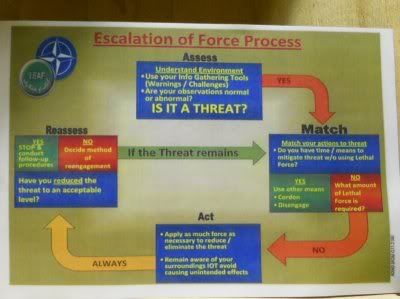So everyone was handed a card that details the steps you should take when you feel threatened, like if a car is driving too fast toward your guard post. They got the presentation, signed their signature, and started carrying the card. Take a moment and look at this thing.

It's an amazing document. The aesthetics are wonderful: the layout is clear, the colors are nice, it fits nicely in a pocket, and the process is irrefutable. I'm sure it went over really well
The only problem is that it gives no particulars and feels like a higher up covering their behind. If a soldier messes up, their superior can protect himself by saying, "Well, he got the brief. I've got his signature here." This despite the fact there are no particulars of any value in the flowchart.
So what *do* you do if there's a car coming up fast on your convoy's tail? No one can say, because there are too many unstated variables in the question. Is it civilian or national police? Is it sitting low on its shocks, like it was overladen with explosives? Who is in the car -- one clean-shaven male adult or a family? Are they going fast but slowing down, or accelerating?
In the end, with only a moment to consider everything, it is us with the weapons who must make a decision .
We need training with its basis in reality, not flowcharts.

No comments:
Post a Comment